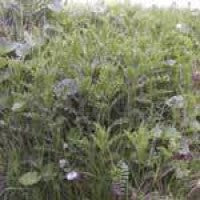Weed of the Week: Spear Thistle (Cirsium vulgare)
Weed of the Week: Spear Thistle (Cirsium vulgare)
By Laurence Gale
What is a weed? By definition a weed is a plant that is growing in the wrong place. Weeds take valuable space, water, sunlight and nutrients that may otherwise be accessible to important crops, in our case turf grasses. Weeds not only compete for these resources they can disfigure and cause problems to playing surfaces.
Weeds are very good competitors and take advantage of any opportunities to colonise turf situations, particularly when the sward is under stress and weak, leaving bare soil areas for weeds to populate. Weeds have many mechanisms and characteristics that enable them to do this, having thick waxy cuticle leaves that can be resistant to some chemicals, fast reproduction methods, the ability to reseed in 6 week cycles and deep tap roots enabling the weed to survive in compacted dry ground conditions.
Weeds have one of three life cycles: annual; biennial or perennial.
- Annual weeds: Live for a single season. These weeds germinate from seed in the spring or summer, flower and then die.
- Biennial weeds: Live for two seasons. During the first growing season, these weeds remain in a vegetative stage and, in the following year, produce flowers, set seed and die.
- Perennial weeds: Live for multiple seasons and flower more than once. Perennial structures (rhizomes, stolons, crowns, entire plants or roots) survive from year to year.
Some weeds may be harmful to the environment or noxious to your regional ecology. For example Japanese Knotweed (Fallopia Japonica) is fast becoming a major weed problem on road side verges and urban landscape areas, a very difficult weed to eradicate. It is very important to recognise weeds and seek effective controls methods to eradicate them from our facilities.
Weeds can also be used as an indicator of soil conditions. For example, knotweed and plantains both indicate soil compaction because they can maintain adequate root respiration at lower oxygen diffusion levels than other plants. Different weeds tolerate different soil conditions, some are alkaline loving and others acid loving. Getting to understand and recognise the physiology of these plants will help you become better turfgrass managers.
This week's weed is: Spear Thistle (Cirsium vulgare)
|
Scientific name
Family Life cycle |
Cirsium vulgare
Compositae Bi-annual |
|
| Form / Appearance | These weeds are generally found on waste ground and unmanaged pasture lands where seeds are able to germinate and establish without too much competition. This plant is a bi- annual plant establishing from seed in the first year to form a rosette type of growth which, in the second year, develops into a larger plant having long stems that bear the flower and seed. Once the plant has produced the seed it will then die. |
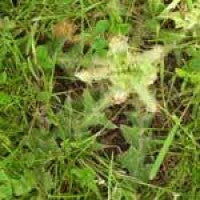
|
| Roots | The roots of thistles form a branched taproot, ensuring the plant has good anchorage into the ground. |
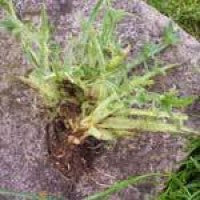
|
| Flowers |
The flowering stems begin to emerge from the rosettes when the basal leaves reach 15-30cm in length. These stems typically reach 30-100cm in height. From July onwards plants produce large purple flower heads 3-5cm long by 2-5cm across, in loose clusters forming the stereotype image of a thistle. The flowering stems die back after producing seeds. |

|
| Leaves | The leaves of the thistle are dark green, rough and hairy on the upper surface. Leaves are deeply divided, each lobe terminating in a sharp rigid spine. |
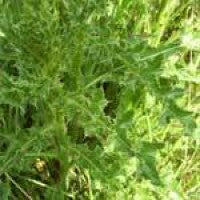
|
| Reproductive method | Spear thistle reproduces from seed with a pappus or 'parachute' of long hairs which is capable of carrying it over very long distances. Seed production is prolific, most seed heads producing about 100 seeds. The seeds are grey or light brown with brown or black longitudinal markings, 3-5 mm long, 1.5 mm wide, smooth, somewhat flattened and sometimes slightly curved; pappus of soft feathery hairs 2-2.5 cm long. |

|
| Habitat | Thistles can be found on most soil situations but are more commonly seen to establish on disturbed ground. Thistles are common and widespread in the UK. |
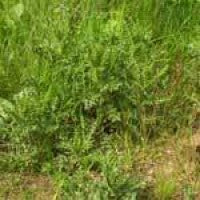
|
| Miscellaneous info | Under the Weeds Act 1959 the Secretary of State may serve an enforcement notice on the occupier of land on which injurious weeds are growing, requiring the occupier to take action to prevent the spread of injurious weeds. The Weeds Act specifies five injurious weeds: Common Ragwort, Spear Thistle, Creeping of Field Thistle, Broad leaved Dock and Curled Dock. See link : Weed Act 1959 |
|
| Cultural Control |
The plant is not a strong competitor in dense vegetation, occurring mainly in overgrazed degenerating pastures of high soil fertility. Spear thistle does not invade perennial pastures that have reasonable vegetation cover in summer and autumn. Plants may be killed by cultivation at the rosette stage. Mowing prior to flowering will assist in reducing the rate of seed spread. (no flowers no seed)
Hand hoeing is effective for individual plants and small patches provided the growing point and the top 20 to 40mm of the tap root are removed.
|
|
| Chemical Control |
Apply selective broadleaf herbicides when plant growth is active. There are a number of products available for controlling broad leaf weeds in established turf.
These chemicals are best used when the weeds are actively growing, usually between April-October.
These herbicides are usually applied as a liquid using watering cans, knapsack sprayers and vehicle mounted sprayers. Ensure you follow manufacturer's directions, health & safety and product data sheets, and comply with COSHH regulations, when using these chemicals. Herbicides are an effective tool where high quality turf is desired. However, they must be applied with care and accuracy and in the context of a good overall turf management program. Before using any herbicide, carefully review the label for conditions of use including rates, methods of application, and precautions. Never use an herbicide in any manner contrary to its label and be sure that the herbicide will not injure the turfgrass species |

